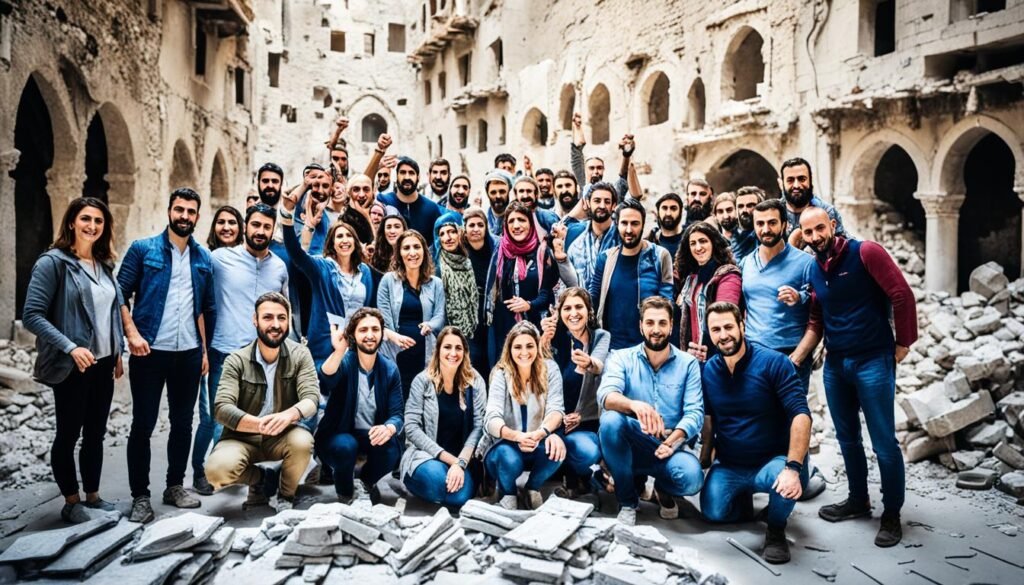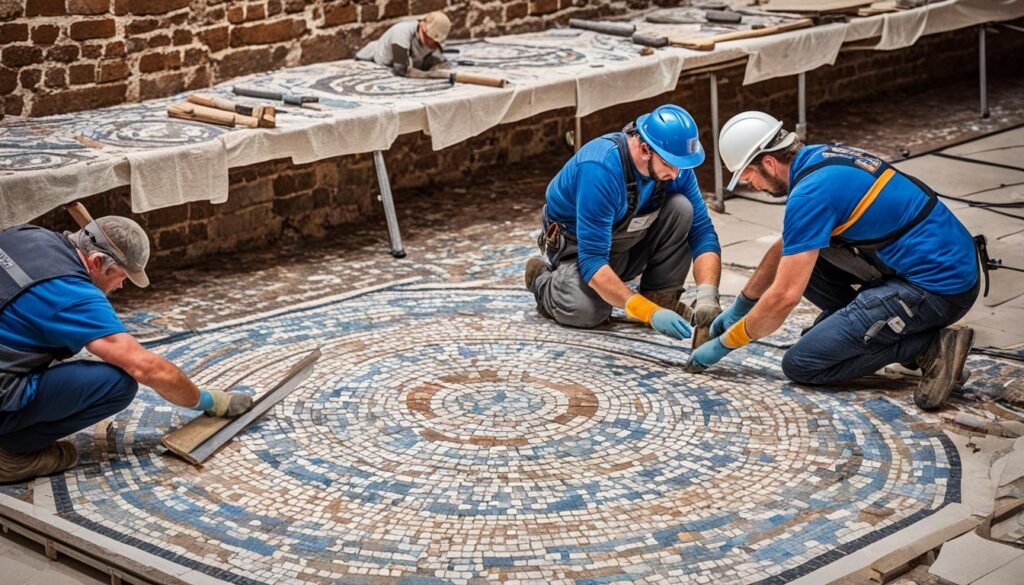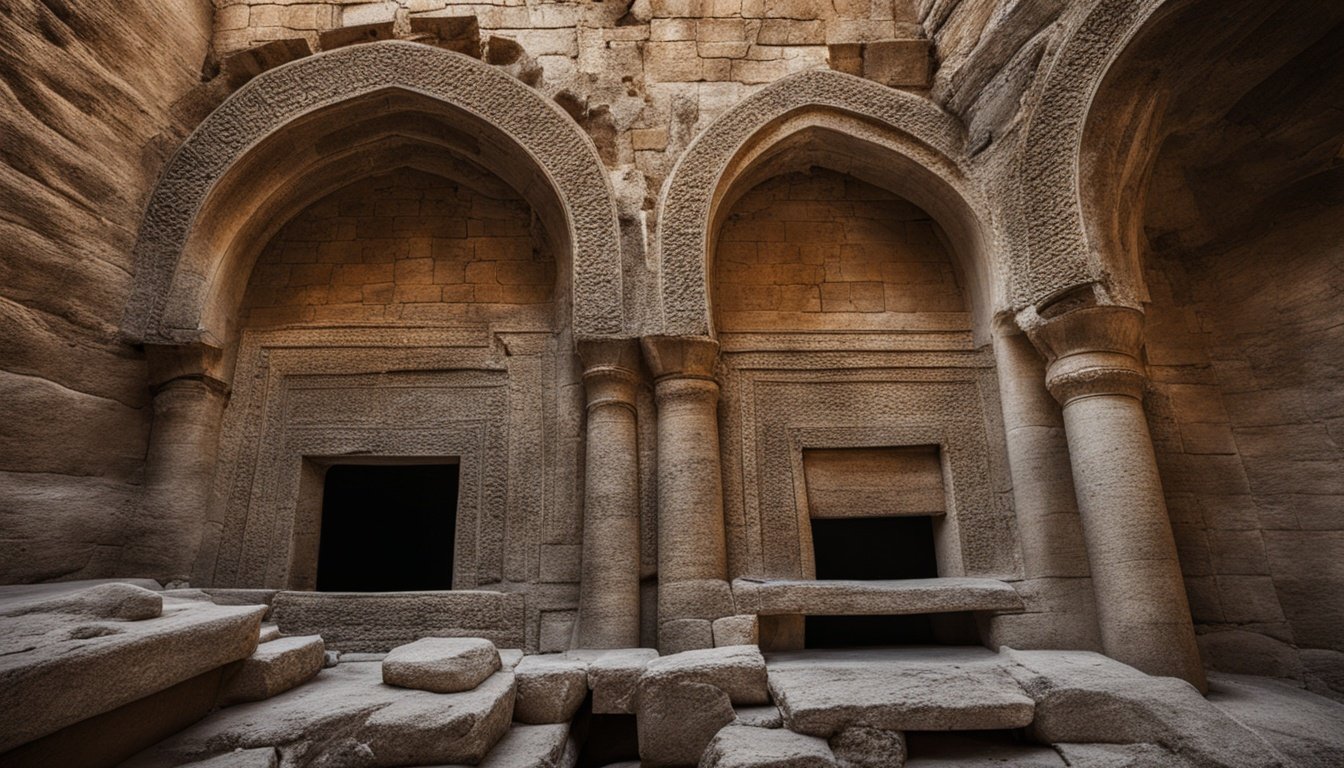Astonishingly, over 1.5 million Syrian artifacts have been relocated to secure underground facilities since the outbreak of the Syrian civil war in 2011. This remarkable effort, led by the Directorate-General of Antiquities and Museums in Syria, has been crucial in safeguarding the country’s rich cultural heritage during a time of conflict. As the former head of this department, Professor Maamoun Abdulkarim, can attest, protecting ancient treasures in the midst of war is a daunting challenge, but one that must be met to preserve the identity and collective memory of the Syrian people.
Professor Abdulkarim, who served as a volunteer without compensation, has been at the forefront of Syria’s cultural heritage preservation efforts. He has worked tirelessly to develop strategies to secure museum holdings and archaeological sites, ensuring that the country’s invaluable artifacts are protected from the ravages of war. From the ancient city of Damascus to the UNESCO World Heritage site of Palmyra, the preservation of Syria’s antiquities has become a critical mission, one that has garnered international attention and support.
Key Takeaways
- Over 1.5 million Syrian artifacts have been relocated to secure underground facilities since the start of the Syrian civil war in 2011.
- The Directorate-General of Antiquities and Museums in Syria has led the efforts to safeguard the country’s cultural heritage during the conflict.
- Professor Maamoun Abdulkarim, the former head of the department, has played a crucial role in developing strategies to protect museum holdings and archaeological sites.
- The preservation of Syria’s antiquities, including in the ancient city of Damascus and the UNESCO World Heritage site of Palmyra, has become a critical mission.
- Professor Abdulkarim’s dedication to this cause, serving as a volunteer without compensation, underscores the importance of preserving Syria’s cultural identity and collective memory.
Introduction: Cultural Heritage Preservation in Conflict Zones
Safeguarding cultural heritage during periods of crisis and armed conflict is a significant challenge that heritage preservation professionals must confront. As head of the Directorate-General of Antiquities and Museums in Syria during the country’s civil war, Maamoun Abdulkarim faced this task firsthand. Abdulkarim developed innovative strategies to protect Syria’s vast cultural legacy, serving as a volunteer to preserve Syrian cultural heritage and rescue invaluable artifacts that serve as markers of identity and collective memory for the Syrian people.
Significance of Protecting Antiquities During Crises and Wars
Cultural heritage sites and artifacts hold immense significance, representing the shared history and identity of a people. Protecting these invaluable resources during periods of conflict is crucial, as they can be targeted for destruction or looting, erasing important connections to the past. Preserving cultural heritage is not merely an academic pursuit but a means of maintaining a sense of community and belonging, even in the face of upheaval.
Challenges Faced by Heritage Preservation Efforts in Syria
Despite Abdulkarim and his team’s tireless efforts, they encountered numerous obstacles in their mission to safeguard Syria’s archaeological sites and museum collections during the civil war. The unpredictable and rapidly evolving nature of the conflict, coupled with limited resources and security risks, made their task exceptionally challenging. Protecting cultural heritage preservation in conflict zones requires nimble, innovative, and collaborative approaches to overcome these daunting challenges.
The Directorate-General of Antiquities and Museums’ Role
The Directorate-General of Antiquities and Museums in Syria, founded in 1946, is the government agency responsible for the protection, promotion, and excavation of the country’s cultural heritage sites. When the violence escalated throughout Syria in 2012, the Directorate’s director, Maamoun Abdulkarim, and his team developed a comprehensive plan to safeguard the nation’s museum collections and archaeological sites.
Mandate and Objectives
The Directorate-General’s primary mandate is to preserve and promote Syria’s rich cultural heritage, which includes over 34 museums and numerous archaeological sites across the country. Their objectives focus on implementing effective cultural heritage preservation strategies to mitigate the impact of the ongoing conflict.
Strategies to Safeguard Museum Holdings and Archaeological Sites
In response to the escalating violence, the Directorate-General took decisive action to evacuate all museum artifacts and transfer them to secure underground facilities equipped with surveillance cameras and safeguards against explosions, fire, and theft. Additionally, they worked closely with local communities in areas where institutions were absent to protect archaeological sites from looting and damage.
Through these proactive measures, the Directorate-General of Antiquities and Museums played a crucial role in preserving Syria’s rich cultural heritage during a time of crisis, ensuring that the country’s invaluable historical treasures were protected for future generations.
Evacuating Artifacts from Syrian Museums
As the situation in Syria deteriorated, the Directorate-General of Antiquities and Museums team recognized the urgent need to safeguard the country’s invaluable cultural heritage. In the summer of 2012, they made the critical decision to evacuate museum collections and transfer them to secure underground facilities.
Relocating to Fortified Storage Facilities
The team carefully selected underground warehouses equipped with surveillance cameras and designed to withstand explosions, fires, and theft. They also relocated important historical documents, particularly from the Ottoman period, to these fortified spaces. This proactive measure aimed to preserve the priceless museum artifact evacuation and protect Syria’s cultural treasures from the escalating conflict.
Navigating Transportation Challenges
However, the transportation of these artifacts posed significant challenges. The roads between Damascus and other cities were fraught with security risks, making the movement of these fragile and irreplaceable museum pieces a delicate and dangerous operation. The team had to meticulously plan and execute the transportation procedures to ensure the safe relocation of the artifacts to the secure storage facilities.
The decision to evacuate the museum collections and the subsequent transportation operations demonstrated the Directorate-General of Antiquities and Museums’ unwavering commitment to preserving Syria’s cultural heritage, even in the face of the ongoing crisis. By securing the artifacts in fortified underground facilities, they took a crucial step in safeguarding the nation’s invaluable historical and artistic treasures.
Syria: Middle Eastern antiquities preservation Damascus Syria
Damascus, the capital of Syria, stands as a testament to the rich cultural heritage of the Middle East. This ancient city, with its winding alleyways and awe-inspiring architectural wonders, has long been a hub for preserving the region’s storied past. As the conflict in Syria escalated, the Directorate-General of Antiquities and Museums focused its efforts on safeguarding the Damascus cultural heritage and ancient Damascene structures.
Despite the challenges posed by the ongoing crisis, the dedicated team worked tirelessly to reinforce the city’s museums with sturdy iron doors, alarm systems, and surveillance cameras. Their goal was to protect the invaluable collections that could not be evacuated, ensuring the heritage preservation in Damascus remained a top priority.

The ancient structures that dot the Damascus landscape are a testament to the city’s enduring spirit. From the iconic Umayyad Mosque to the intricate Damascene houses, these ancient Damascene structures are not only marvels of architecture but also a vital link to the region’s storied past. By safeguarding these landmarks, the Directorate-General of Antiquities and Museums aims to preserve the cultural heritage that has defined Damascus for centuries.
The Palmyra Mission: Rescuing World Heritage
Palmyra is one of the most significant UNESCO World Heritage sites, renowned for its historical significance, well-preserved ancient buildings, and diverse archaeological treasures. When the ancient city fell into the hands of ISIS terrorists in 2015, the Directorate-General of Antiquities and Museums in Syria acted swiftly to safeguard the invaluable artifacts housed in the Palmyra National Museum.
Under the cover of darkness, the team coordinated with the Syrian military police to transport three truckloads of hundreds of statues and artifacts from the museum across the desert. This nighttime evacuation operation was a critical step in preserving the region’s cultural heritage during a time of great turmoil. After the liberation of Palmyra in 2016, the team worked tirelessly for two months to empty the museum, rescuing hundreds of ancient statues, including the impressive 15-ton statue of the Lion of Al-Lat (Athena).
Importance of Palmyra as a UNESCO World Heritage Site
Palmyra, a city located in central Syria, has been recognized as a UNESCO World Heritage site due to its exceptional historical significance and the diversity of its well-preserved ancient buildings. This ancient oasis city was an important hub for trade and cultural exchange, boasting a unique blend of Greco-Roman and Persian architectural styles.
Nighttime Evacuation of Artifacts from the Palmyra National Museum
When Palmyra fell to ISIS in 2015, the Directorate-General of Antiquities and Museums in Syria acted swiftly to safeguard the invaluable artifacts housed in the Palmyra National Museum. Under the cover of darkness, the team coordinated with the Syrian military police to transport three truckloads of hundreds of statues and artifacts from the museum across the desert, ensuring the safety of these priceless cultural treasures.
International Cooperation and Support
While the Directorate-General of Antiquities and Museums team in Syria faced immense challenges in preserving the country’s cultural heritage during the ongoing conflict, they were not alone in their efforts. International organizations, such as UNESCO, stepped in to provide crucial support and resources to safeguard Syria’s irreplaceable artifacts and archaeological sites.
UNESCO’s Pivotal Role
UNESCO, the United Nations Educational, Scientific and Cultural Organization, has been at the forefront of efforts to raise global awareness about the devastating impact of the crisis on Syria’s cultural heritage. The organization has actively monitored the situation, pursued short-term, medium-term, and long-term actions to protect threatened sites, and worked closely with the Directorate-General to coordinate preservation activities.
Collaborative Efforts with Local Communities and NGOs
In addition to the support from UNESCO, the Directorate-General has also collaborated with local communities and non-governmental organizations (NGOs) in their efforts to protect and preserve Syria’s archaeological sites and museum collections. These partnerships have been instrumental in engaging the local population, fostering a sense of ownership and stewardship over the cultural heritage, and ensuring the sustainability of preservation efforts.

Through these international cooperation and local community collaboration initiatives, the Directorate-General has been able to leverage resources, expertise, and community engagement to bolster its ongoing efforts to safeguard Syria’s irreplaceable cultural treasures during this challenging period.
Ethical Tourism Management of Prehistoric Sites
In a collaborative effort between the Directorate-General of Antiquities and Museums and Damascus University, a new initiative aims to improve the ethical tourism management of prehistoric sites in Syria. This project focuses on balancing the conservation and sustainability of these invaluable cultural treasures with their potential as educational resources and community engagement opportunities.
The key priorities of this initiative include raising awareness about Syria’s prehistoric sites, adopting effective techniques and technologies to enhance accessibility and knowledge, rethinking site presentation for non-formal educational experiences, and strengthening the role of these sites in sustainable tourism practices. By considering the ethical and sustainable management of prehistoric sites, the project hopes to preserve Syria’s rich cultural heritage while fostering a deeper appreciation and connection with local communities.
One of the primary objectives is to integrate the local community into the preservation and presentation of these prehistoric sites. This approach not only empowers the community but also ensures that the benefits of sustainable heritage tourism are equitably distributed. Additionally, the initiative explores innovative ways to utilize these sites as educational resources, offering non-formal learning opportunities that inspire a new generation to appreciate the significance of Syria’s ancient past.
Through this comprehensive approach, the Directorate-General of Antiquities and Museums, in collaboration with Damascus University, aims to set a new standard for ethical tourism management of prehistoric sites. By striking a balance between conservation, community engagement, and educational enrichment, this project seeks to safeguard Syria’s invaluable cultural heritage while promoting sustainable and responsible tourism practices.
Raising Awareness and Community Involvement
The Directorate-General of Antiquities and Museums, alongside institutions like Damascus University, have spearheaded initiatives to heighten awareness about the significance of Syria’s cultural heritage and the ongoing efforts to preserve it. These campaigns encompass educational programs and non-formal learning opportunities, engaging children and youth in the vital task of safeguarding the nation’s historical treasures.
By integrating local communities into the preservation process, the team aims to foster a sense of ownership and investment, ensuring the long-term sustainability of their heritage preservation endeavors. Through collaborative efforts, residents are empowered to participate actively and benefit from the project outcomes, ultimately strengthening the bond between people and their shared cultural legacy.

Educational Initiatives and Non-formal Learning Opportunities
The Directorate-General of Antiquities and Museums has developed a range of educational programs and non-formal learning initiatives to engage the public, particularly young learners, in the preservation of Syria’s cultural heritage. These efforts seek to instill a deeper understanding and appreciation for the country’s rich history, fostering a sense of pride and responsibility among the next generation.
Integrating Local Communities for Sustainable Heritage Preservation
Recognizing the importance of community involvement, the Directorate-General of Antiquities and Museums has made concerted efforts to integrate local stakeholders into the preservation process. By empowering residents to participate and benefit from the project outcomes, the team aims to ensure the long-term sustainability of their heritage preservation initiatives, creating a lasting impact on the communities they serve.
Legal Framework and Policy Recommendations
As the Directorate-General of Antiquities and Museums in Syria works to preserve the country’s rich cultural heritage, strengthening the legal framework and implementing effective policies have become essential priorities. The team recognizes the need to review the existing cultural heritage laws to prevent the gradual loss of authenticity in protected properties and ensure that violations within the urban fabric are stopped and controlled.
To address these critical challenges, the organization has emphasized the importance of establishing a specialized unit for Disaster Risk Management and Prevention. This unit would coordinate emergency response efforts and proactively work to prevent further damage to Syria’s invaluable cultural treasures. By enhancing the heritage protection regulations, the Directorate-General aims to strengthen the legal framework and empower its efforts to safeguard the country’s irreplaceable heritage.
Strengthening Cultural Heritage Laws and Regulations
The Directorate-General of Antiquities and Museums is committed to reviewing and strengthening the existing cultural heritage laws to ensure they provide robust protection for Syria’s historic sites and artifacts. This includes addressing legal loopholes and implementing stricter measures to prevent violations and control illegal activities that have often threatened the integrity of the country’s cultural heritage.
Preventing Violations and Controlling Illegal Activities
Recognizing the urgent need to safeguard Syria’s cultural treasures, the Directorate-General is focusing on developing comprehensive strategies to prevent violations and control illegal activities that have previously jeopardized the preservation of the country’s irreplaceable heritage. This includes strengthening heritage protection regulations and establishing specialized units to coordinate emergency response and disaster risk management efforts.
Lessons Learned and Best Practices
The Directorate-General of Antiquities and Museums’ experiences during the Syrian conflict have provided invaluable lessons for cultural heritage preservation in conflict zones. The team has emphasized the crucial role of preparedness and emergency response planning when it comes to protecting antiquities and artifacts during times of crisis and war.
Adapting to changing circumstances and developing innovative solutions has also been a key focus for the Directorate-General. They have shared their strategies and best practices with international colleagues, such as the UNESCO team that created an emergency plan for the National Museum of Sudan, in an effort to assist other countries facing similar challenges in safeguarding their cultural heritage.
Importance of Preparedness and Emergency Response Planning
The Directorate-General’s team has underscored the significance of being proactive and having a comprehensive emergency response plan in place before a crisis erupts. This includes identifying potential risks, securing vulnerable sites, and training personnel on emergency procedures. By prioritizing heritage preservation lessons and emergency response planning, the Directorate-General has been able to respond more effectively to the evolving situation in Syria.
Adapting to Change and Innovative Solutions
The Syrian conflict has presented a constantly changing landscape, requiring the Directorate-General to adapt its strategies and develop innovative solutions to overcome the challenges. This has involved exploring new technologies, collaborating with international experts, and engaging local communities in the preservation efforts. By embracing a spirit of adaptability and innovation, the team has been able to navigate the complexities of the situation and implement effective measures to safeguard Syria’s priceless cultural heritage.

Conclusion
The Directorate-General of Antiquities and Museums’ efforts to preserve Syria’s cultural heritage during the country’s civil war have been a testament to the importance of protecting cultural legacies, even in the face of overwhelming adversity. Through their dedication, innovation, and collaborative approach, the team has managed to safeguard a significant portion of Syria’s invaluable antiquities and ancient structures, ensuring that the country’s rich cultural heritage remains intact for future generations.
As the world continues to grapple with the challenges of preserving heritage in conflict zones, the lessons learned and best practices developed by the Directorate-General of Antiquities and Museums in Syria will serve as a valuable guide for other nations facing similar challenges. The preservation of cultural heritage is not only a matter of historical significance, but also a crucial aspect of maintaining the identity and resilience of communities in the face of crisis.
Syria’s cultural heritage, embodied in the ancient structures and artifacts of Damascus and Palmyra, serves as a testament to the enduring spirit of the Syrian people. The efforts to safeguard these treasures during the ongoing conflict are a testament to the power of human resilience and the importance of collective action in the face of adversity. As the world looks to the future, the lessons learned in Syria will undoubtedly shape the way we approach the preservation of cultural heritage in conflict-affected regions around the globe.
Source Links
- Directorate-General of Antiquities and Museums and Damascus University – https://www.iccrom.org/projects/directorate-general-antiquities-and-museums-and-damascus-university
- When War Comes for the Museum | Essay – https://www.zocalopublicsquare.org/2022/05/11/syria-cultural-heritage-museum/ideas/essay/
- UNESCO World Heritage Centre – State of Conservation (SOC 2017) Ancient City of Damascus (Syrian Arab Republic) – https://whc.unesco.org/en/soc/3544/


